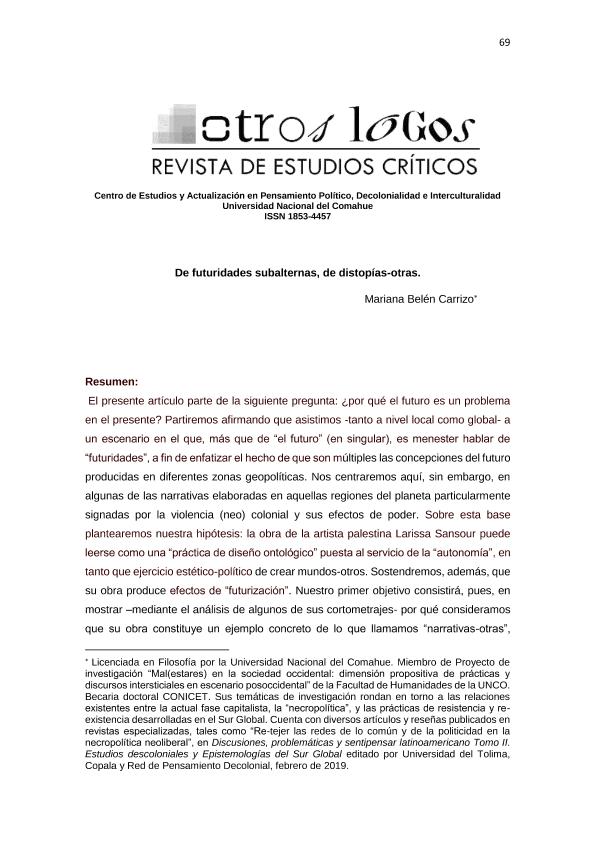Artículo
El presente artículo parte de la siguiente pregunta: ¿por qué el futuro es un problema en el presente? Partiremos afirmando que asistimos -tanto a nivel local como global- a un escenario en el que, más que de “el futuro” (en singular), es menester hablar de “futuridades”, a fin de enfatizar el hecho de que son múltiples las concepciones del futuro producidas en diferentes zonas geopolíticas. Nos centraremos aquí, sin embargo, en algunas de las narrativas elaboradas en aquellas regiones del planeta particularmente signadas por la violencia (neo) colonial y sus efectos de poder. Sobre esta base plantearemos nuestra hipótesis: la obra de la artista palestina Larissa Sansour puede leerse como una “práctica de diseño ontológico” puesta al servicio de la “autonomía”, en tanto que ejercicio estético-político de crear mundos-otros. Sostendremos, además, que su obra produce efectos de “futurización”. Nuestro primer objetivo consistirá, pues, en mostrar –mediante el análisis de algunos de sus cortometrajes- por qué consideramos que su obra constituye un ejemplo concreto de lo que llamamos “narrativas-otras”, “narrativas subalternas” y, por último, caracterizaremos algunas de las estrategias mediante las cuales logra romper con la imposición de ciertos modos canónicos e idealizados de narrase, supuestamente reservados para las poblaciones periferializadas del Sur Global. This article starts from the following question: why is the future a problem in the present? We will begin by saying that it is necessary to speak of "futurities", rather than "the future", in the singular: there are multiple visions of the future produced in different geopolitical zones. In this article, however, we will focus on some of the narratives elaborated in those regions of the planet particularly marked by (neo) colonial violence. On this basis, we will pose a first hypothesis: the work of the Palestinian artist Larissa Sansour can be read as a practice of "ontological design" put at the service of “autonomy”, because it is an aesthetic-political exercise that creates other-worlds. We will show, then, that her work produces effects of “futurization”, by multiplying the ways of thinking the relationship between "the real" and "the possible". Therefore, our first objective will be to show how her work constitutes a concrete example of what we call "other-narratives", "subaltern narratives". Secondly, we will characterize some of the strategies through which she breaks with the imposition of certain canonical and idealized ways of narration, supposedly reserved for the peripherialized populations of the Global South.
De futuridades subalternas, de distopías-otras
Fecha de publicación:
12/2019
Editorial:
Universidad Nacional del Comahue. Facultad de Humanidades
Revista:
Otros Logos. Revista de Estudios Críticos
ISSN:
1853-4457
Idioma:
Español
Tipo de recurso:
Artículo publicado
Clasificación temática:
Resumen
Palabras clave:
FUTURIDADES
,
DISEÑO
,
AUTONOMÍA
,
NARRATIVAS SUBALTERNAS
Archivos asociados
Licencia
Identificadores
Colecciones
Articulos(IPEHCS)
Articulos de INSTITUTO PATAGONICO DE ESTUDIOS DE HUMANIDADES Y CIENCIAS SOCIALES
Articulos de INSTITUTO PATAGONICO DE ESTUDIOS DE HUMANIDADES Y CIENCIAS SOCIALES
Citación
Carrizo, Mariana Belén; De futuridades subalternas, de distopías-otras; Universidad Nacional del Comahue. Facultad de Humanidades; Otros Logos. Revista de Estudios Críticos; 10; 12-2019; 69-84
Compartir




